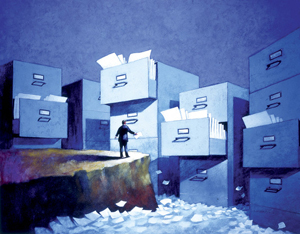
I know… you probably think of filing as the most boring job in the world, and there are probably a 101 other thing that you would prefer to do instead. However, as a solo business owner, it is down to you to do the filing and stay organized. As a result this is one of the areas that a lot of solo business owners find overwhelming – they simply do not know where to start, or how to systemize their business.
Papers here; papers there; papers everywhere!
The more piles of paper there are, the more overwhelmed they feel!
Creating and maintaining a filing system is the very foundation that your business is built on, so this is the first system you need to put in place – an efficient and effective filing system. And one that is simple to use too!
With a proper filing system in place you will very quickly and easily be able to find the information you need, when you need it.
Let me share with you below my 7 easy steps for creating your ideal filing system:
1. Determine your storage needs. Whether you decide to opt for a plastic filing crate, or a dedicated filing cabinet, one thing you need to keep in mind that you will need TWICE as much space as you think you’ll need.
2. Decide how you naturally look for information. This will determine what your filing system will look like, and how you will set up your files. For example are you a person who thinks in alphabetical terms, or does categorization serve you better? Remember – this is YOUR filing system so you need to do what works for YOU.
3. Categorize your filing drawers/crates. For example if you have a two-drawer filing cabinet, use the top drawer for business files and the bottom drawer for personal files. You decide how best to categorize your filing drawers. But don’t just put all your files together in one drawer without any system otherwise you won’t be able to find anything again!
4. Gather your supplies. Tabbed file folders work best simply because there are no holes to punch or fiddly clasps to undo. You simply drop your papers into your file – making filing your paperwork a cinch!
5. Create quick and easy access to your day-to-day files. A stepped-sorter holds approximately 8-10 files which step up the further back they are – making your files easily visible. Keep this on your desk, and store in it those files you know you will need access to every day.
6. Now move on to your PC filing system. Your PC is a very large filing cabinet, so it makes sense to create a similar filing system here as you did for your paper files. That way you do not have to manage two different filing systems – it’s the same system except one is physical, and the other is electronic.
7. Create a system for your emails. Again, follow a very similar or the same system for creating email folders as you did for your paper and PC files. Outlook and Thunderbird allow you to create different mail folders.
Consistency is the key to an easy-to-use, successful filing system. Create the same files and folders for your paper-based system, your PC system, and your email program.